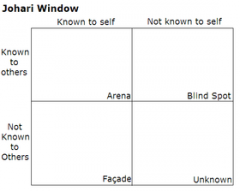![]()
![]()
![]()
Use LEFT and RIGHT arrow keys to navigate between flashcards;
Use UP and DOWN arrow keys to flip the card;
H to show hint;
A reads text to speech;
38 Cards in this Set
- Front
- Back
|
Benevolent Lie |
a lie that is not considered malicious by the person who tells it |
|
|
Equivocation |
a statement that is not false but cleverly avoids an unpleasant truth |
|
|
Face |
the image an individual wants to project to the world |
|
|
Facework |
actions people take to preserve their own and others' presenting images |
|
|
Impression Management |
the communication strategies people use to influence how others view them |
|
|
Johari Window |

a model that described the relationship between self-disclosure and self-awareness |
|
|
Lie |
a deliberate act of deception |
|
|
Perceived Self |
the person we believe ourselves to be in moments of candor; it may be identical with or different from the presenting and desired selves |
|
|
Presenting Self |
the image a person presents to others; may be identical to or different from the perceived and desired selves |
|
|
Privacy Management |
the choices people make to reveal or conceal information about themselves |
|
|
Reference Groups |
groups against which we compare ourselves, thereby influencing our self-concept and self-esteem |
|
|
Reflected Appraisal |
the theory that a person's self-concept matches the way the person believes others regard him or her (will.i.am Sesame Street song) |
|
|
Self-Concept |
the relatively stable set of perceptions each individual holds of himself or herself |
|
|
Self-Disclosure |
the process of deliberately revealing information about oneself that is significant and that would not normally be known to others |
|
|
Self-Esteem |
the part of the self-concept that involves evaluations of self-worth |
|
|
Self-Fulfilling Prophecy |
the causal relationship that occurs when a person's expectations of an event and her or his subsequent behavior based on those expectations make the outcome more likely to occur than would otherwise have been true |
|
|
Significant Other |
a person whose opinion is important enough to affect one's self-concept strongly |
|
|
Social Comparison |
evaluating oneself in terms of or by comparison to others |
|
|
Social Penetration Model |
a model that describes relationships in terms of their breadth and depth |
|
|
Perceived Self |
the you behind the curtain, the relative idea of who you are |
|
|
Self-Esteem |
the judgement of who you are as a person (high or low) |
|
|
You feel uncomfortable as a 6th grader starting middle school, but really good as a senior who is graduating, then back to feeling uncomfortable as a college freshman |
the perceived and presenting selves are dynamic, not stable... give an example of this |
|
|
Explicit Communication |
the self-theory that explains why "you" statements often play an impactful role in people's self-concept and self-esteem |
|
|
Implicit Communication |
the self-theory that involves verbal and nonverbal messages; often times our interpretations of other's messages may influence our self-concept and self-esteem |
|
|
My perception of your perceptions of me may influence my perception of me |
What are the three layers of perception? |
|
|
Significant Others |
the people whose perceptions you use to make your own perceptions of yourself |
|
|
Self-Fulfilling Prophecy |
our own experiences of us will influence our behaviors |
|
|
Pygmalion Effect |
other's expectations of us influence our behaviors (positive) |
|
|
Golem Effect |
negative expectations = negative results |
|
|
Reference Groups |
the people we most frequently compare ourselves to: friends, family, parents, colleagues, classmates, celebrities, athletes |
|
|
Manner |
Communicatively Constructing Identities: Goffman - verbal and nonverbal steps that we take towards presenting ourselves |
|
|
Appearance |
Communicatively Constructing Identities: Goffman - body endowment and body adornment |
|
|
Setting |
Communicatively Constructing Identities: Goffman - Another term for "artifacts": contextual details, car you drive, posters on your wall, laptop you use, etc |
|
|
-Reference -Hyphenation -Nonverbal Cues -Naming Practices -Marked and Unmarked Terms -Narratives -Rituals |
other ways to express Communicatively Constructing Identities: Goffman |
|
|
when you place a term in front of another term when there is something abnormal or potentially problematic with the term (ex. nurse vs male nurse) |
What is a Marked Term? |
|
|
1. Climate 2. Input (how much content is given) 3. Response Opportunity 4. Feedback |
What are the 4 Impactful Factors in the creation of the self? |
|
|
Reflected Appraisal |
your self-concept can be seen as a reflection of the messages you've received throughout your life |
|
|
Cognitive Conservatism |
the tendency to seek information that conforms to an existing self-concept (people with high self-esteem seek out partners who view them favorably and vice-versa) |

